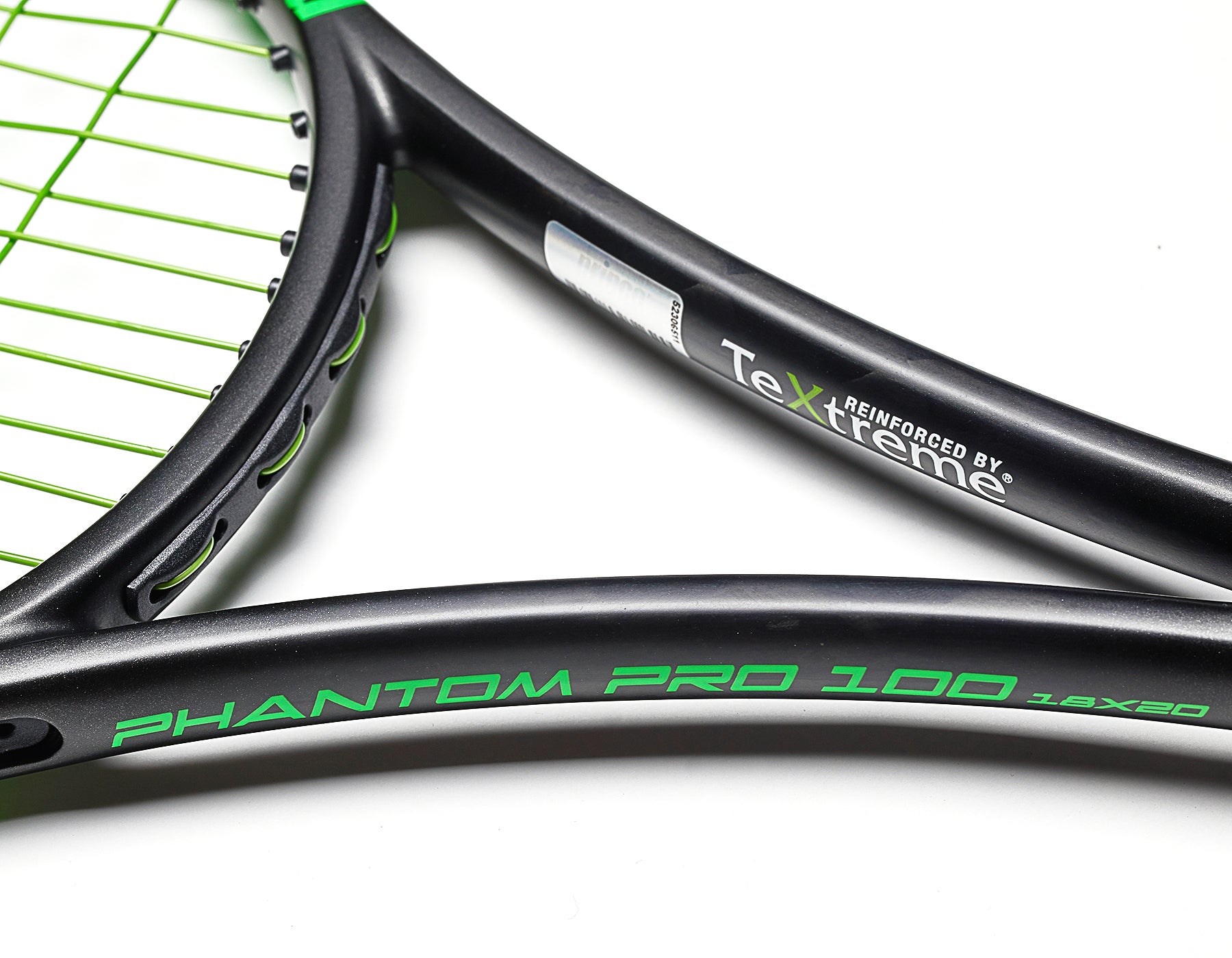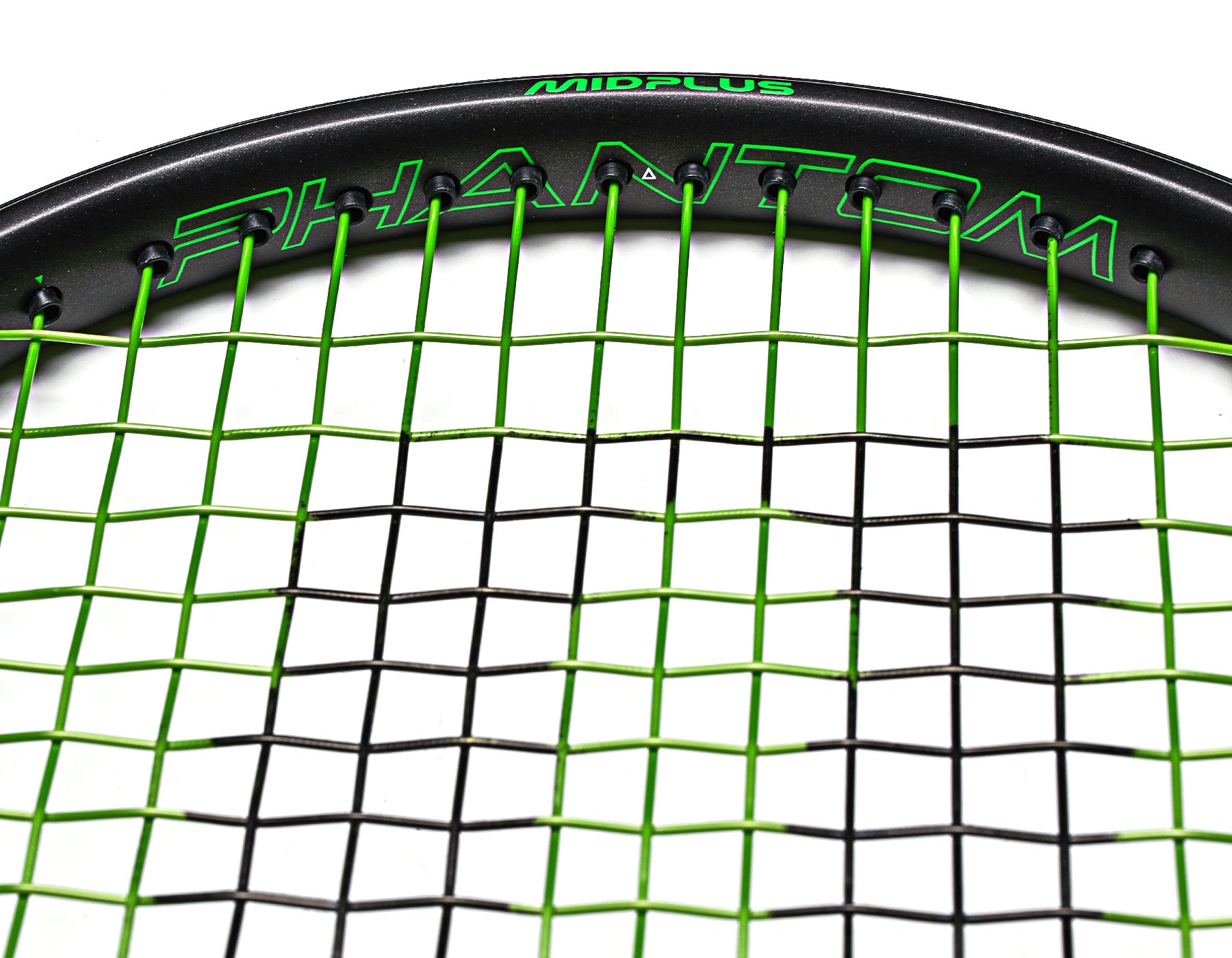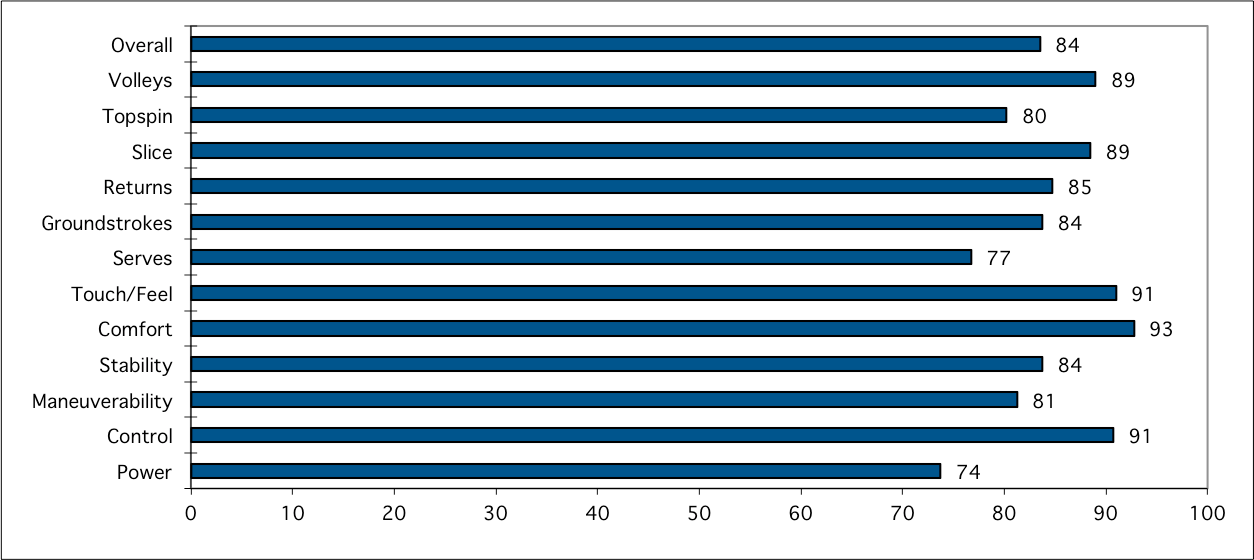Prince Phantom Pro 100 18x20 Racquet Review
| Groundstrokes | 84 |
| Volleys | 89 |
| Serves | 77 |
| Returns | 85 |
| Power | 74 |
| Control | 91 |
| Maneuverability | 81 |
| Stability | 84 |
| Comfort | 93 |
| Touch/Feel | 91 |
| Topspin | 80 |
| Slice | 89 |
With a wonderfully thin beam and a tight, controlled string pattern, the Prince Phantom Pro 100 18x20 promises classic feel in a modern racquet. Our playtesters were salivating at the chance to hit with another new Phantom, and they quickly discovered some of this racquet's amazing attributes. From the baseline, the racquet aids in control and targeting. Though it’s a bit lower powered, this racquet's nearly 12-ounce strung weight supplies just enough mass to help big hitters deploy their shots. Despite the tighter 18x20 string pattern, our team found enough spin to keep the ball dipping in the court when needed. Four very different players reviewed this racquet, but they all agreed on how well the Phantom Pro 100 18x20 performed at net. They also concurred that power on serves was somewhat limited. All in all, one thing was evident from everyone's very first hit: The Phantom Pro 100 18x20 will appeal to players craving control, feel and flexibility from their racquet.
Upsides
- Control
- Feel
Downsides
- Somewhat underpowered, especially on serves
Bottom Line
Unlike more modern racquets, this classic-style frame doesn't focus on raw power and instead boasts loads of control and feel.
Ability
Advanced
Groundstrokes - Score: 84
The Phantom Pro 100 18x20 was loaded with control and feel from the baseline. To get power on his shots, Chris needed to use a full swing and transfer his weight into the court. He began, "I played my best tennis when moving the ball around the court with a focus on placement and consistency. It was a great fit when counterpunching against a big hitting opponent, as I could redirect pace with accurate shots. This racquet felt very natural when I was right up on the baseline and taking the ball on the rise. I liked the control and feel I had with my slice backhand and felt very confident with that stroke. I was also able to generate plenty of topspin to get my shots to drop well inside the lines. I was taking full swings with this racquet since it is so low powered, and that offered up lots of racquet head speed to turn into spin."
"Hitting and drilling with this racquet was sublime, but this playtest proved to be an interesting one for me," said Michelle, who normally uses a stiffer, more powerful racquet. “The Phantom Pro 100 18x20 felt great and was so control and feel oriented that it messed with my head at times! I didn't feel like I could be effective playing my aggressive game. The 18x20 offered nice control, and I wasn’t hindered in terms of depth or spin too often. The flex was nice and buttery, and the racquet had a lower powered feel. I felt comfortable hitting big and ramping up the pace in a rally. However, the second I got into a pressure situation my brain flipped a switch, and I was very aware that this racquet offered me less raw power and had a tighter, more controlled stringbed than most racquets I play successfully with. Instantly, I started trying to do too much with each shot. Instead of waiting for the right ball to attack, I felt pressured to attack quicker in the point, which led to inconsistency and frustration on my end. I found myself pulling up and rushing through the ball rather than lengthening my shots and hitting out. This has nothing to do with the racquet and its playability, so to combat this I need to spend more time playing with it to feel comfortable in match situations. I did add a bit of mass to the tip of the racquet for more plow through, and that helped me subconsciously more than anything. With that being said, I would say players used to a stiffer setup and thicker beam should check this racquet out, but they should expect an adjustment period."
Erik felt extremely connected to the ball on groundstrokes. He said, "My slices were staying very low; I could knife the ball effectively and as hard as I wanted. It took me a while to get used to the launch angle and the control-oriented feel, but the Phantom Pro 100 18x20 was very maneuverable and made it easy to generate racquet head speed. This racquet wasn't great for my game unless I was taking the ball early and really driving through it, or coming to net constantly. I tended to hit a lot of slice with this racquet, and I felt like I had to hit a flatter ball to get a better result, as opposed to my usual loopy topspin ball."
It was all about feel for Kristen on groundstrokes. She explained, "The feel was incredible. I noticed right away that this racquet was more stable than my Prince Phantom Pro 100 16x18, and that it offered more plow through. However, it was also apparent that this racquet was beefier in weight, and that weight, combined with the tighter string pattern, meant I had to work a lot harder to get depth and pace and to win points from the back of the court. My racquet just swung so much freer through the air, and I didn't have to exert as much energy to construct points."

Volleys - Score: 89
The net is where our playtesters felt that the Phantom Pro 100 18x20 shone the brightest. Michelle had no complaints at all about the Phantom Pro 100’s volleys. She said, "This racquet absorbed power well and let me feel in command of every volley I hit. Anything that was blasted at me was easy to block back. Touch was outstanding. I loved the feel when volleying, whether I was approaching aggressively or playing defensively."
This was Erik's favorite part of the playtest. He described, "The feel of this Phantom Pro 100 18x20 was exceptional. It was very responsive up at net, and I felt like I could put my volleys anywhere. I found myself hitting shorter, more angled volleys, but I could also punch my shots deep if I wanted to. I felt extremely connected to the ball and loved the response up at net."
Although Kristen had issues with the weight of the Phantom Pro 100 from the baseline, the weight was an asset at net. She said, "While I preferred my own Phantom from the back of the court, I definitely liked this model more at net. The stability was top notch; I never found it getting pushed around. It offered great touch for dropping a volley short and packed a punch when playing a put-away volley."
The inherent feel and control in the Phantom Pro 100 18x20 made it a fun racquet for Chris at net. He said, "I felt very dialed in on my touch volleys. The stable response allowed me to take a heavy incoming ball and drop it for a short angle. My placement was very precise, so I could be aggressive with my targeting. There wasn't a ton of free power, but I found enough to put the ball away."

Serves - Score: 77
All of our playtesters quickly noticed the lower powered response of the Phantom Pro 100 18x20 on serve, but Erik also found a good amount of control. He said, "I really liked serving slices out wide, and I could place the ball effectively. I didn't get a ton of pop from this racquet on serves, but I could hit nice angled shots. I was confident and felt like the response was very predictable. My favorite serves to hit were the slice serve out wide on the deuce side and the T serve on the ad side."
Serving was one area where Kristen struggled with the Phantom Pro 100 18x20. She explained, "The racquet came around a bit slowly overhead, so I never felt like I got dialed in on a consistent service motion. I had the most success with slice serves, and I could get them to land pretty deep in the box. However, as my energy for serving started to drop as I played more points during a session, and I was hitting more serves into the net than normal. While this racquet felt a bit more solid on contact compared to the 16x18 in stock form, I missed the whippy nature and easy head speed of that racquet."
Chris was also looking for more power on serve. He noted, "I served well with this racquet when feeling fresh, but as a match wore on I found it tougher to maintain good pace. I'd likely add a little weight to the tip of the racquet and string it lower to juice it up a bit. Still, I always had lots of control and found spin easy to generate. I could get the racquet through contact easily, which was good because I had to maximize racquet head speed to get power."
Michelle found the racquet to be mediocre when serving. She said, "This racquet performed just fine on serves, but it didn’t excel. Precision was solid, and I could hit my targets well. Like the other playtesters, I craved a bit more power and pop. I felt limited with the 18x20 string pattern and missed more than I would have liked into the top of the net. I didn't start points off as offensively as I prefer to, which led to me feeling rushed to attack quickly off the next shot, even if it wasn't the right ball. I eventually added a bit of weight and upped the mass behind the ball, which helped."

Returns - Score: 85
While they struggled a bit on serves, our team had a fine time returning with the Phantom Pro 100 18x20. In fact, Kristen thought that returning with this racquet was one of the best parts of the playtest. She said, "I didn't have the same issue with maneuverability that I did on serve, so I could swing big and attack serves when I had the chance. I felt like I was hitting a heavy ball off returns and was getting a controlled response, which allowed for great placement. Returns and volleys were the two highlights of the playtest for me."
Chris concurred, adding, "The comfortable and controlled response of the Phantom Pro 100 18x20 made it a great racquet for returns. I returned consistently and found I could take a generous swing without overhitting. I liked driving returns off both wings and was able to generate good pace off an incoming serve. My slice backhand return also worked well with this racquet. I was able to drive the slice, float it deep or hit a short angle depending on how I wanted to develop the point."
Contrary to her expectations, Michelle never quite clicked with this racquet on returns. She explained, "I was expecting to love returning with this racquet, but I have to admit that I struggled initially. The sweetspot never felt huge, and if I wasn't making contact right there, I didn't feel super connected to my shot. This is where I realized I really do prefer thicker beams. I was missing a bit of stability and plow through on my returns. I could hit my targets effectively, but I couldn't attack as well as I can with other racquets. Honestly, I think this might be an adjustment period issue, and I think I would feel better about executing bigger returns if I had more time to get comfortable with this racquet."
Erik played aggressively when returning with this racquet. He said, "Due to the ample control, I could rip the ball off the return and still get it to drop in the court. This racquet was very solid on first serve returns; I could chip the ball back nice and low. On second serve returns I could attack the ball with no fear of missing long. This racquet was very maneuverable and easy to get around my body."
Overall - Score: 84
| Technical Specifications | ||
|---|---|---|
| Length | 27 in | 69 cm |
| Head Size | 100 sq in | 645 sq cm |
| Weight | 11.9 oz | 337 gm |
| Balance Point | 12.4 in 31 cm | 9pts Head Light |
| Construction | 20.5mm / 19.5mm / 16.5mm / | |
| Composition | Textreme/Graphite | |
| String Pattern | 18 Mains / 20 Crosses | |
| Babolat RDC Ratings | ||
|---|---|---|
| Score | Grade | |
| Flex Rating | 55 | Range: 0-100 |
| Swing Weight | 326 | Range: 200-400 |
| Chris' Scores | |||
|---|---|---|---|
| Power | 7.4 | Serves | 7.8 |
| Control | 9.5 | Groundstrokes | 8.4 |
| Maneuverability | 8 | Returns | 8.7 |
| Stability | 8.5 | Slice | 9 |
| Comfort | 9.8 | Topspin | 8.4 |
| Touch/Feel | 9.5 | Volleys | 8.7 |
| Overall | 8.4 | ||
| Michelle's Scores | |||
|---|---|---|---|
| Power | 7 | Serves | 7.5 |
| Control | 9 | Groundstrokes | 8.5 |
| Maneuverability | 8 | Returns | 7.8 |
| Stability | 7.8 | Slice | 8.8 |
| Comfort | 9.5 | Topspin | 7.8 |
| Touch/Feel | 9 | Volleys | 9 |
| Overall | 8.3 | ||
| Erik's Scores | |||
|---|---|---|---|
| Power | 7.8 | Serves | 8.4 |
| Control | 9 | Groundstrokes | 8.3 |
| Maneuverability | 8.6 | Returns | 8.5 |
| Stability | 8.4 | Slice | 8.8 |
| Comfort | 8.8 | Topspin | 8 |
| Touch/Feel | 8.9 | Volleys | 8.9 |
| Overall | 8.3 | ||
| Kristen's Scores | |||
|---|---|---|---|
| Power | 7.3 | Serves | 7 |
| Control | 8.8 | Groundstrokes | 8.3 |
| Maneuverability | 7.9 | Returns | 8.9 |
| Stability | 8.8 | Slice | 8.8 |
| Comfort | 9 | Topspin | 7.9 |
| Touch/Feel | 9 | Volleys | 9 |
| Overall | 8.4 | ||
Playtester Profiles
Chris: 4.5 all-court player currently using the Tecnifibre TFlash 300 PS. Chris uses a full-western forehand grip, has a fast swing style and hits a one-handed backhand.
Michelle: Open level baseline player with a semi-western forehand and a two handed backhand. She currently plays with the Wilson Pro Staff RF 97 Autograph.
Erik: Open level all-court player with a one-handed backhand and a western forehand. He is currently using the Prince Textreme Tour 100 (310).
Kristen: 5.0 level player with a semi-western forehand and a two handed backhand. Kristen currently plays with a Prince Phantom Pro 100.










Likes
Chris - "I love the control, feel and comfort. This Phantom Pro 100 18x20 definitely gives me the confidence to swing big."
Michelle - "Great feel. Good control and precision with decent plow through."
Erik - "I like the low slice I can hit with this racquet. I also like the touch and feel up at net and how comfortable the frame is on impact."
Kristen - "Good plow through and stability, comfortable feel."
Dislikes
Chris - "The Phantom Pro 100 18x20 is just a tad low powered for me in stock form, and I had a tendency to hit too short."
Michelle - "As a player coming from thicker beams and open string patterns, I was hoping for a bit more stability and a bigger sweetspot. I’d also like a little more plow through and mass behind the ball."
Erik - "The launch angle is a little low for me, and I feel like this Phantom Pro 100 18x20 needs some more weight up at 10 and 2 o'clock for a little more plow through."
Kristen - "This racquet is a bit too control oriented for my tastes. I would like a little more free power to help me out in point play."
Comparing the racquet to others they've tried, our testers said:
Chris - "I would compare this Phantom Pro 100 18x20 to the Wilson Ultra Tour, Dunlop Srixon CX 200 Tour 18x20 and Tecnifibre TFight 315 Ltd 18x20. However, this Prince racquet has a more flexible feel. All of these racquets offer tons of control, comfort and feel, but none quite as much as the Phantom Pro 100 18x20."
Michelle - "I haven't hit a ton with the other Prince Phantoms, aside from the Phantom Pro 93P. This Phantom Pro 100 18x20 offers a bit more maneuverability and is more forgiving compared to the 93P, but I like that the 93P has more plow through. Feel and flex were pretty consistent between the two."
Erik - "The Phantom Pro 100 18x20 just doesn't suit my game as well as some other frames. This racquet is more control oriented and has a little more feel than my racquet of choice. I would compare it to the Wilson Blade 98. There's more feel and control with this Prince frame, but it’s very similar to the Blade maneuverability-wise."
Kristen - "As stated throughout my comments, this Phantom Pro 100 18x20 definitely offers greater stability and plow through than the 16x18 model. However, with the heftier weight and tighter string pattern, you definitely have to work harder for depth and power. While I loved the solid feel and touch of the 18x20 at net and on returns, the 16x18 model remains my favorite in the Phantom series; it caters better to my game overall."